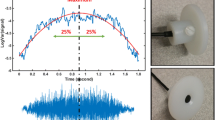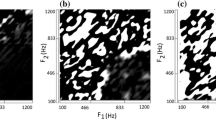Abstract
Sleep apnoea syndrome is common in the general population and is currently underdiagnosed. The aim of the present work was to develop a new tracheal sound feature for separation of apnoea events from non-apnoea time. Ten overnight recordings from apnoea patients containing 1,107 visually scored apnoea events totalling 7 h in duration and 72 h of non-apnoea time were included in the study. The feature was designed to describe the local spectral content of the sound signal. The median, maximum and mean smoothing of different time scales were compared in the feature extraction. The feature was designed to range from 0 to 1 irrespective of tracheal sound amplitudes. This constant range could offer application of the feature without patient-specific adjustments. The overall separation of feature values during apnoea events from non-apnoea time across all patients was good, reaching 80.8%. Due to the individual differences in tracheal sound signal amplitudes, developing amplitude-independent means for screening apnoea events is beneficial.




Similar content being viewed by others
References
Abeyratne UR, Karunajeewa AS, Hukins C (2007) Mixed-phase modeling in snore sound analysis. Med Biol Eng Comput 45:791–806. doi:10.1007/s11517-007-0186-x
American Academy of Sleep Medicine (1999) Sleep related breathing disorders in adults: recommendation for syndrome definition and measurement techniques in clinical research. Sleep 22:667–689
Beck R, Rosenhouse G, Mahagnah M et al (2005) Measurements and theory of normal tracheal breath sounds. Ann Biomed Eng 33:1344–1351. doi:10.1007/s10439-005-5564-7
Brietzke SE, Mair EA (2007) Acoustical analysis of pediatric snoring: what can we learn? Otolaryngol Head Neck Surg 136:644–648. doi:10.1016/j.otohns.2006.11.056
Cummiskey J, Williams TC, Krumpe PE et al (1982) The detection and quantification of sleep apnea by tracheal sound recordings. Am Rev Respir Dis 126:221–224
Earis JE, Cheetham BMG (2000) Current methods used for computerized respiratory sound analysis. Eur Resp Rev 10:586–590
Gibson GJ (2004) Obstructive sleep apnoea syndrome: underestimated and undertreated. Br Med Bull 72:49–64. doi:10.1093/bmb/ldh044
Hult P, Wranne B, Ask P (2000) A bioacoustic method for timing of the different phases of the breathing cycle and monitoring of breathing frequency. Med Eng Phys 22:425–433. doi:10.1016/S1350-4533(00)00050-3
Huupponen E, Saastamoinen A, Saunamäki T et al (2009) Improved computational fronto-central sleep depth parameters show differences between apnea patients and control subjects. Med Biol Eng Comput 47:3–10
Iber C, Ancoli-Israel S, Chesson AL et al (2007) The AASM manual for the scoring of sleep and associated events: rules, terminology, and technical specifications. American Academy of Sleep Medicine, Westchester
Kaniusas E, Pfützner H, Saletu B (2005) Acoustical signal properties for cardiac/respiratory activity and apneas. IEEE Trans Biomed Eng 52:1812–1822. doi:10.1109/TBME.2005.856294
Kulkas A, Rauhala E, Huupponen E et al (2008) Detection of compressed tracheal sound patterns with large amplitude variation during sleep. Med Biol Eng Comput 46:315–321. doi:10.1007/s11517-008-0317-z
Marcos JV, Hornero R, Alvarez D et al (2008) Radial basis function classifiers to help in the diagnosis of the obstructive sleep apnoea syndrome from nocturnal oximetry. Med Biol Eng Comput 46:323–332. doi:10.1007/s11517-007-0280-0
Meslier N, Simon I, Kouatchet A et al (2002) Validation of a suprasternal pressure transducer for apnea classification during sleep. Sleep 25:753–757
Min SD, Yoon DJ, Yoon SW et al (2007) A study on a non-contacting respiration signal monitoring system using Doppler ultrasound. Med Biol Eng Comput 45:1113–1119. doi:10.1007/s11517-007-0246-2
Mita M (2007) Algorithm for the classification of multi-modulating signals on the electrocardiogram. Med Biol Eng Comput 45:241–250. doi:10.1007/s11517-006-0130-5
Nakano H, Hayashi M, Ohshima E et al (2004) Validation of a new system of tracheal sound analysis for the diagnosis of sleep apnea-hypopnea syndrome. Sleep 27:951–957
Penzel T, McNames J, Murray A (2002) Systematic comparison of different algorithms for apnoea detection based on the electrocardiogram recordings. Med Biol Eng Comput 40:402–407. doi:10.1007/BF02345072
Peter JH, Koehler U, Grote L et al (1995) Manifestations and consequences of obstructive sleep apnoea. Eur Respir J 8:1572–1583
Rauhala E, Hasan J, Kulkas A et al (2008) Compressed tracheal sound analysis in screening of sleep-disordered breathing. Clin Neurophysiol 119:2037–2043. doi:10.1016/j.clinph.2008.04.298
Rossi M, Sovijärvi AR, Piirilä P et al (2000) Environmental and subject conditions and breathing manoeuvres for respiratory sound recordings. Eur Respir Rev 10:611–615
Skomro RP, Kryger MH (1999) Clinical presentations of obstructive sleep apnea syndrome. Prog Cardiovasc Dis 41:331–340. doi:10.1053/pcad.1999.0410331
Sovijärvi AR, Helistö P, Malmberg LP et al (1998) A new versatile PC-based lung sound analyzer with automatic crackle analysis (HeLSA); repeatability of spectral parameters and sound amplitude in healthy subjects. Technol Health Care 6:11–22
Sovijärvi AR, Malmberg L, Charbonneau G et al (2000) Characteristics of breath sounds and adventitious respiratory sounds. Eur Respir Rev 10:591–596
Tiihonen P, Pääkkönen A, Mervaala E et al (2008) Design, construction and evaluation of an ambulatory device for screening of sleep apnea. Med Biol Eng Comput (in press)
Wittmann V, Rodenstein DO (2004) Health care costs and the sleep apnea syndrome. Sleep Med Rev 8:269–279. doi:10.1016/j.smrv.2004.01.002
Yadollahi A, Moussavi ZM (2006) A robust method for estimating respiratory flow using tracheal sounds entropy. IEEE Trans Biomed Eng 53:662–668. doi:10.1109/TBME.2006.870231
Yamashiro SM (2007) Non-linear dynamics of human periodic breathing and implications for sleep apnea therapy. Med Biol Eng Comput 45:345–356. doi:10.1007/s11517-006-0153-y
Young T, Palta M, Dempsey J et al (1993) The occurrence of sleep-disordered breathing among middle-aged adults. N Engl J Med 328:1230–1235. doi:10.1056/NEJM199304293281704
Acknowledgments
This study was financially supported by the National Technology Agency of Finland, the Research fund of the Tampere University Hospital, the Jenny and Antti Wihuri foundation, the Tampere Tuberculosis foundation, the Emil Aaltonen foundation, the Instrumentarium science foundation, as well as the Finnish Cultural foundation.
Author information
Authors and Affiliations
Corresponding author
Rights and permissions
About this article
Cite this article
Kulkas, A., Huupponen, E., Virkkala, J. et al. New tracheal sound feature for apnoea analysis. Med Biol Eng Comput 47, 405–412 (2009). https://doi.org/10.1007/s11517-009-0446-z
Received:
Accepted:
Published:
Issue Date:
DOI: https://doi.org/10.1007/s11517-009-0446-z




